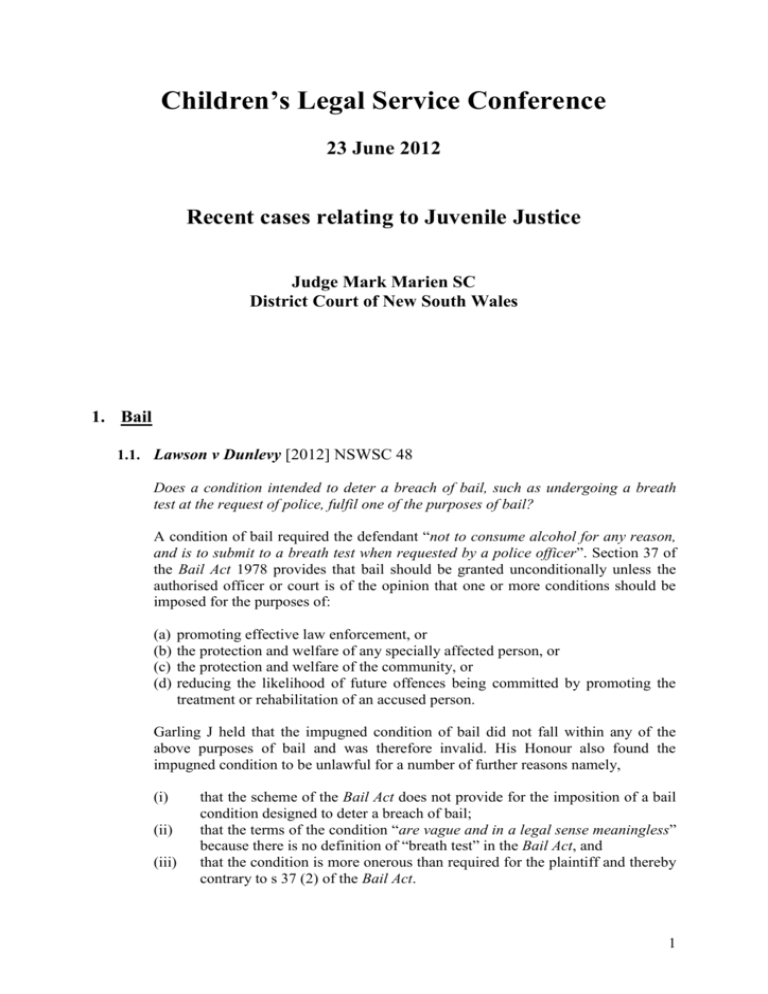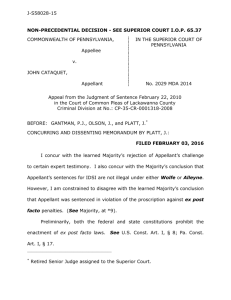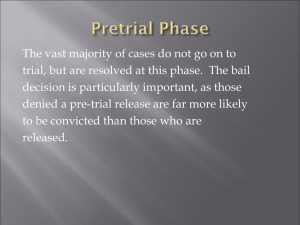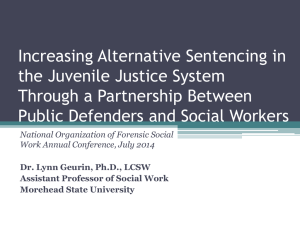Recent cases relating to Juvenile Justice
advertisement

Children’s Legal Service Conference 23 June 2012 Recent cases relating to Juvenile Justice Judge Mark Marien SC District Court of New South Wales 1. Bail 1.1. Lawson v Dunlevy [2012] NSWSC 48 Does a condition intended to deter a breach of bail, such as undergoing a breath test at the request of police, fulfil one of the purposes of bail? A condition of bail required the defendant “not to consume alcohol for any reason, and is to submit to a breath test when requested by a police officer”. Section 37 of the Bail Act 1978 provides that bail should be granted unconditionally unless the authorised officer or court is of the opinion that one or more conditions should be imposed for the purposes of: (a) (b) (c) (d) promoting effective law enforcement, or the protection and welfare of any specially affected person, or the protection and welfare of the community, or reducing the likelihood of future offences being committed by promoting the treatment or rehabilitation of an accused person. Garling J held that the impugned condition of bail did not fall within any of the above purposes of bail and was therefore invalid. His Honour also found the impugned condition to be unlawful for a number of further reasons namely, (i) (ii) (iii) that the scheme of the Bail Act does not provide for the imposition of a bail condition designed to deter a breach of bail; that the terms of the condition “are vague and in a legal sense meaningless” because there is no definition of “breath test” in the Bail Act, and that the condition is more onerous than required for the plaintiff and thereby contrary to s 37 (2) of the Bail Act. 1 Sometimes a bail condition is placed on a young person (in conjunction with a curfew condition) that the young person present themselves to police conducting bail checks at their residence. The reasoning of Garling J in this case lends authority to the proposition that it is beyond power to impose such a condition. 2. Sentencing 2.1. JT v R [2011] NSWCCA 128 When does the emphasis on rehabilitation of young people shift towards greater consideration of protection of the community in sentencing? This was an unsuccessful sentence appeal by a juvenile offender following the imposition of a custodial sentence for an aggravated robbery contrary to s 96 of the Crimes Act 1900, which is a serious children’s indictable offence. The appellant, who was aged 16 years and 7 months at the time of the offence, was sentenced to a total sentence of 6 years with a non-parole period of 3 years, 2 months. The CCA rejected the ground of appeal that the sentence was manifestly excessive. Hoeben J (McClellan CJ at CL and Grove AJ agreeing) set out a number of principles that apply to the sentencing of young offenders, extracted from KT v Regina [2008] NSWCCA 51 and went on to note the relevance of general deterrence and retribution in the sentencing exercise on this occasion: 22 The principles relevant to the sentencing of children have been discussed on many occasions. Both considerations of general deterrence and principles of retribution are, in most cases, of less significance than they would be when sentencing an adult for the same offence. In recognition of the capacity for young people to reform and mould their character to conform to society's norms, considerable emphasis is placed on the need to provide an opportunity for rehabilitation. ... 23 The law recognises the potential for the cognitive, emotional and/or psychological immaturity of a young person to contribute to their breach of the law. Accordingly, allowance will be made for an offender's youth and not just their biological age. ... The weight to be given to the fact of the offender's youth does not vary depending upon the seriousness of the offence. ... Where the immaturity of the offender is a significant factor in the commission of the offence, the criminality involved will be less than if the same offence was committed by an adult. ... 24 Although accepted to be of less significance than when sentencing adults, considerations of general deterrence and retribution cannot be completely ignored when sentencing young offenders. There remains a significant public interest in deterring antisocial conduct. ... 25 The emphasis given to rehabilitation rather than general deterrence and retribution when sentencing young offenders, may be moderated when the 2 young person has conducted him or herself in the way an adult might conduct him or herself and has committed a crime of violence or considerable gravity. ... In determining whether a young offender has engaged in "adult behaviour"... the court will look to various matters including the use of weapons, planning or pre-meditation, the existence of an extensive criminal history and the nature and circumstances of the offence. ... Where some or all of these factors are present the need for rehabilitation of the offender may be diminished by the need to protect society. Hoeben J continued: 34 I am not persuaded that this is the sort of offence which indicates impulsivity and immaturity on the part of the applicant so that the need for rehabilitation should be given paramount consideration. Rather, this is the very sort of offence that McClellan CJ at CL had in mind when qualifying his initial statement of principle in paras [24] and [25] of KT v Regina. 35 This is the sort of case where general deterrence and retribution cannot be ignored. The bashing of a 14-year-old child into insensibility during the course of a prolonged attack by two significantly older youths is very much the sort of crime of violence and considerable gravity which his Honour had in mind. The existence in this case of an extensive criminal history, the nature and circumstances of the offence and the applicant's obduracy in continuing to commit offences of considerable violence meant that rehabilitation did not have the force which it would normally have when sentencing a juvenile. 36 Similar observations were made by Dunford J in R v MA [2004] NSWCCA 92 where his Honour said: 28 ... There comes a point at which the seriousness of the crime committed by a young offender, particularly if a crime of violence, is so great that the special attention normally given to rehabilitation in the case of young offenders must give way, and greater emphasis given to punishment and deterrence. The relevant principle was summarised in the joint judgment of this Court in R v AEM Snr and Ors [2002] NSWCCA 58 at [97] - [98] as follows: "It is well accepted that in the case of youth, general deterrence and public denunciation usually play a subordinate role to the need to have regard to individual treatment aimed at rehabilitation.... However, important as that principle is, it cannot defeat the primary purpose of punishment nor, in circumstances where young offenders conduct themselves in a way which an adult does, can it stand in the way of the need to protect society." 37 In R v Pham and Ly (1991) 55 A Crim R, Lee CJ at CL said at p 135: "It is true that courts must refrain from sending young persons to prison unless that course is necessary. But the gravity of the crime and the fact that it is a crime of violence frequently committed by persons even in their teens must be kept steadfastly in mind otherwise the protective aspect of the criminal courts' function will cease to operate. In short, deterrence 3 and retribution do not cease to be significant merely because persons in their late teens are the persons committing grave crimes, particularly crimes involving physical violence to persons in their own homes." 38 Contrary to the applicant's submissions, her Honour did take into account all relevant principles. She took into account the requirements of s 6 of the Children (Criminal Proceedings) Act 1987 and to the extent that it was applicable, the guideline judgment in Henry. In that regard Henry has been held to apply to the sentencing of juveniles (R v SDM [2001] NSWCCA 158). 39 The approach followed by her Honour was consistent with the observations of this Court in R v McHarg [2011] NSWCCA 115 where Johnson J (with whom Whealy JA and Hidden J) agreed) said: 146 ... It was important that the objective seriousness of his offences not be overshadowed by his youth and the undoubted desire to take steps to foster his rehabilitation. It remained necessary as well to have regard to issues of personal and general deterrence. In relation to crimes of violence committed on the streets by groups of young persons, consideration of general deterrence should be given substantial weight, notwithstanding the youth of the offenders: AI v R [2011] NSWCCA 95 at [69]. 147 Given the Respondent's past history of committing offences despite non-custodial sentencing orders in the Children's Court, and his commission of these offences whilst subject to conditional liberty by way of bonds or bail (or both), specific deterrence remained a significant factor on sentence. The Court reaffirmed that the Guideline Judgment in Henry applies to juveniles: see also R v SDM [2001] NSWCCA 158 although s 6 of the Children (Criminal Proceedings Act) 1987 and other sentencing principles applicable to juveniles must also be taken into account. 2.2. BJT v R [2011] NSWCCA 12 When should the sentence of a young person be backdated to take account of quasicustodial sentence served in residential rehabilitation? The 17-year-old young person (who apparently had an intellectual disability) was sentenced for the offences of robbery armed with an offensive weapon and inflicting actual bodily harm with intent to have sexual intercourse. After his arrest he spent three months in custody and was then released on bail to live at a residential facility operated by ADAHC. He remained there for just over six months before committing further offences and having his bail refused. When sentenced, there was no backdating to allow for the time spent in the residential rehabilitation facility. The CCA was satisfied that “In this case it appears that the accommodation at Tarlo met the strict requirements that correspond to quasicustody.” The sentence was backdated to allow for 50% of the time spent in the facility. 4 JM v R [2012] NSWCCA 83 Is it permissible to take into account in determining the length of the non-parole period the fact that, pursuant to s 19 of the CCPA, a juvenile offender will serve part of their sentence in an adult facility? The appellant appealed against sentences imposed upon him for the offence of inflicting grievous bodily harm with intent to do so (s 33(1) of the Crimes Act 1900) and a charge of affray (s 93C(1) of the Crimes Act). The appellant was aged 17 years and 4 months at the time of the commission of the offences. On the first charge he was sentenced to imprisonment for 7 years with a non-parole period of 4 years. For the affray, he was sentenced to a wholly concurrent sentence of 12 months imprisonment. The sentencing judge made a “recommendation” (as distinct from an order) purportedly under s 19(3) of the Children (Criminal Proceedings) Act 1987 (CCPA) that the appellant serve his sentence in a juvenile detention centre. After considering the operation of s 19 of the CCPA, Simpson J concluded that there were “special circumstances” within the meaning of s 19 (3) of the CCPA warranting the appellant serving part of his sentence as a juvenile offender after he has attained the age of 18 years. However, Simpson J concluded that it is “inevitable” that the appellant will serve the major part of his nonparole period in an adult facility and that that is a relevant consideration to the determination of the length of the non-parole period to be imposed. However, the majority (Whealy JA and Hoeben J) disagreed with Simpson J on this point. Their Honours found that there were no special circumstances within the meaning of s 19(3), s 19 (4) and (4A) of the CCPA. Their Honours also found that it is impermissible to take into account the nature of the appellant’s custody (in adult detention) so as to shorten the non-parole period. Whealy JA said: “At the very least, the impression will have been created that the sentence has been structured with an eye to avoiding the statutory outcome. This is not permissible: R v Zamagias [2002] NSWCCA 17”. 3. Evidence 3.1. JB v Regina [2012] NSWCCA 12 Are admissions made in private, by a juvenile to a support person, admissible, or are they protected by s 90 Evidence Act? A youth liaison officer was asked to attend a police station to act as a support person for a young person suspected of fatally stabbing another juvenile. The support person spoke with the appellant privately and asked what had happened. The appellant told him that he had stabbed a man. The support person asked the appellant where he had obtained the knife to which he responded that it was in the garden, where he had put it earlier in the night. This evidence was admitted into evidence. 5 On appeal to the CCA it was submitted that Her Honour had applied incorrect principles in her consideration of s 90 Evidence Act and that an element of unfairness arose in admitting the admissions. Unfairness in s 90 Section 90 has “regard to the circumstances in which the admission was made”. In R v Sophear Em [2003] 374, Howie J (at [78]) observed that “It is unfairness arising from the use of the admissions by the prosecution … and not whether the police unfairly treated the accused. The purpose of the discretion is the protection of the rights and privileges of the accused.” The relationship between a support person and a juvenile is not a “special relationship” and is not protected by the legislation. A support person’s fundamental role is to assist the juvenile in his or her dealings with police and to protect them from any disadvantage as a result of their age. Such a role does not demand confidentiality. The provisions for vulnerable people in the Law Enforcement (Powers and Responsibilities) Regulation 2005 and the special protections for juveniles under s 13 Children’s (Criminal Proceedings) Act 1987 do not alter the role of a support person and they do not provide a prohibition on the admissibility of an admission by a juvenile to a support person. The trial judge was correct in allowing the admission into evidence on the ground that it “fell into the category of an unguarded incriminating statement”. She was correct in deciding that the “relevant inquiry was into the appellant’s state of mind and, in particular, whether his freedom to speak or refrain from speaking had been compromised”. Each of these matters was an appropriate and relevant consideration under s 90; at [41]. There were a number of other grounds of appeal and the appellant was unsuccessful on each of them. 3.2. R v D [2011] NSWDC 73; [2011] CLN 3 The young person was charged with armed robbery. During the District Court trial of the matter objection arose on the admissibility of admissions made to a teacher by the young person. Objection was taken pursuant to both s 85 and s 90 Evidence Act. Her Honour determined that the teacher was not an investigating official for the purposes of s 85. She did however determine that admission of the evidence would be unfair pursuant to s 90. This was because the young person was 14, he was a vulnerable person per LEPRA and should have had a support person, the young person had previously declined to be interviewed by police and the teacher was in a position of authority over him. She did note that if the young person had been 16 or 17 she might have taken a different view. 3.3. "RP" v Ellis & Anor [2011] NSWSC 442 Is doli incapax an element which needs to be proven at committal? 6 The 13-year-old young person was charged with malicious wound with intent to inflict grievous bodily harm, which is a serious children's indictable offence. In committal proceedings, which proceeded by way of paper committal, it was submitted that the presumption of doli incapax had not been rebutted. The magistrate found that this was an evidentiary matter and committed the young person for trial. Hoeben J held that the rebuttal of doli incapax was an element which needed to be established by the prosecution: "... there was a misunderstanding on her Honour's part as to the operation of doli incapax as an exclusionary rule of evidence, as opposed to a presumption to be rebutted by the Crown on all of the evidence before the Court. When her Honour considered herself unable to consider the issue because it would lead to the exclusion of evidence, she was asking herself the wrong question.” Markou v R [2012] NSWCCA 64 What is the meaning of “in company’ for the purposes of an offence of assault occasioning actual bodily harm in company (s 59 (2) of the Crimes Act 1900)? Macfarlan JA (with whom RS Hulme and RA Hulme JJ agreed) held at [26] that to prove that M was in company with L, the Crown must prove beyond reasonable doubt that M and L shared a common purpose that embraced the assault of the victim. His Honour said at [28]: “In my view, however, persons are not acting “in company”, with a common purpose, unless there is some express or implied arrangement or understanding between them to act together to achieve an agreed end. Proof of a nod or even a look acknowledging that they will act together may suffice, but a mere coincidence of purpose not resulting from an arrangement or understanding will not be enough”. ooOOoo 7








